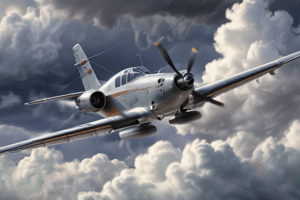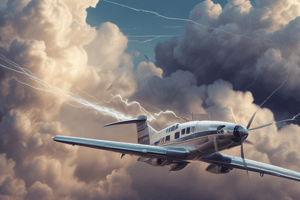Podcast
Questions and Answers
What is a common effect of heavy rain on flight operations?
What is a common effect of heavy rain on flight operations?
- Improved visibility
- No significant impact on flight safety
- Increased risk of hydroplaning on wet runways (correct)
- Reduced runway friction
How does snowfall affect aircraft performance?
How does snowfall affect aircraft performance?
- It increases lift and reduces weight
- It only affects ground operations
- It can cause significant changes to aircraft performance due to accumulation on wings and surfaces (correct)
- It has no significant impact on aircraft performance
What is a potential hazard of sleet on aircraft?
What is a potential hazard of sleet on aircraft?
- Reduced weight
- Increased lift
- Accumulation on surfaces, leading to additional weight and control issues (correct)
- No significant impact on aircraft performance
What occurs when rain falls through a layer of subfreezing air near the ground?
What occurs when rain falls through a layer of subfreezing air near the ground?
What is a potential effect of freezing rain on aircraft?
What is a potential effect of freezing rain on aircraft?
What is a common effect of hail on aircraft?
What is a common effect of hail on aircraft?
Why is freezing rain particularly hazardous for aviation?
Why is freezing rain particularly hazardous for aviation?
What is a potential effect of sleet on runways and taxiways?
What is a potential effect of sleet on runways and taxiways?
Why is it essential for pilots to understand different types of precipitation?
Why is it essential for pilots to understand different types of precipitation?
What is a potential effect of snowfall on ground operations?
What is a potential effect of snowfall on ground operations?
Light to moderate rain never poses a risk to flight.
Light to moderate rain never poses a risk to flight.
Snowfall can only decrease visibility during flight.
Snowfall can only decrease visibility during flight.
Sleet never accumulates on the aircraft's surfaces.
Sleet never accumulates on the aircraft's surfaces.
Freezing rain forms when raindrops freeze before reaching the ground.
Freezing rain forms when raindrops freeze before reaching the ground.
Hail is more common than freezing rain.
Hail is more common than freezing rain.
Freezing rain is the only type of precipitation that can disrupt the aerodynamic flow over the aircraft surfaces.
Freezing rain is the only type of precipitation that can disrupt the aerodynamic flow over the aircraft surfaces.
Rainfall is the most hazardous form of precipitation for aviation.
Rainfall is the most hazardous form of precipitation for aviation.
Snowfall never affects ground operations.
Snowfall never affects ground operations.
Sleet can only affect the aircraft's performance during flight.
Sleet can only affect the aircraft's performance during flight.
Pilots do not need to understand the different types of precipitation to ensure flight safety.
Pilots do not need to understand the different types of precipitation to ensure flight safety.
What are the primary concerns for pilots when encountering heavy rain during flight?
What are the primary concerns for pilots when encountering heavy rain during flight?
How can snow accumulation on aircraft surfaces affect flight operations?
How can snow accumulation on aircraft surfaces affect flight operations?
What makes freezing rain particularly hazardous for aircraft, and what are the potential consequences?
What makes freezing rain particularly hazardous for aircraft, and what are the potential consequences?
How does sleet accumulation on aircraft surfaces affect flight safety?
How does sleet accumulation on aircraft surfaces affect flight safety?
What are the primary hazards of hail for aircraft, and why is it a concern?
What are the primary hazards of hail for aircraft, and why is it a concern?
How can rain affect ground operations, and what are the potential consequences?
How can rain affect ground operations, and what are the potential consequences?
What are the primary concerns for pilots when encountering snowfall during flight?
What are the primary concerns for pilots when encountering snowfall during flight?
How does freezing rain form, and what makes it particularly hazardous for aviation?
How does freezing rain form, and what makes it particularly hazardous for aviation?
What are the primary effects of sleet on runways and taxiways, and how does it impact ground operations?
What are the primary effects of sleet on runways and taxiways, and how does it impact ground operations?
Why is it crucial for pilots to have a thorough understanding of different types of precipitation and their effects on flight operations?
Why is it crucial for pilots to have a thorough understanding of different types of precipitation and their effects on flight operations?
Flashcards are hidden until you start studying
Study Notes
Thunderstorms
- Thunderstorms are a significant weather challenge for aviation, requiring critical knowledge for safe navigation.
- Three essential components for thunderstorm development: moisture, a lifting force, and atmospheric instability.
- Moisture is a critical ingredient, and a lifting force (e.g., cold front, warm air at the surface, or mountain range) is required to elevate this moisture.
- Atmospheric instability sets the stage for a thunderstorm, where warm air rests below cooler air.
Thunderstorm Stages
- Cumulus stage: vigorous updrafts construct cloud towers.
- Mature stage: precipitation begins to form, along with lightning and thunder, indicating intense energy release.
- Dissipating stage: updrafts weaken, and downdrafts prevail, leading to the storm's eventual decay.
Dangers of Thunderstorms
- Severe turbulence, hail, lightning, wind shear, and microbursts pose significant threats to aircraft.
- Microbursts are intense downdrafts that can result in drastic performance drops for aircraft during takeoff or landing.
Safety Measures
- Thorough pre-flight weather briefings to avoid flying into a brewing storm.
- Real-time, in-flight weather updates to navigate away from unforeseen developments.
- Maintain a safe distance (at least 20 nautical miles) from severe storms, take guidance from air traffic control, and be prepared to alter course decisively.
Wind Shear
- Wind shear refers to a rapid change in wind speed or direction over a short distance, posing critical consequences for aircraft during takeoff and landing.
- Causes of wind shear: weather fronts, thunderstorms, or topography.
- Microbursts are an intense form of wind shear that can occur during thunderstorms, posing severe risks for aircraft.
Wind Shear Safety Measures
- Thorough pre-flight weather briefings to identify potential wind shear conditions.
- Onboard detection systems and technologies, such as the Low-Level Wind Shear Alert System (LLWAS).
- Training and preparedness for wind shear situations are essential in a pilot's skill set.
Pilot Response to Wind Shear
- Techniques to maintain control over the aircraft's performance during wind shear conditions, such as powering up and adopting a nose-down attitude in a headwind shift.
Precipitation and Flight Safety
- Rain: light to moderate rain typically poses minimal risk, but heavy rain can reduce visibility and alter runway friction.
- Snow: snowfall can decrease visibility and affect aircraft performance due to accumulation on wings and surfaces.
- Sleet: sleet can accumulate on aircraft surfaces, leading to additional weight and potential control issues, and create slippery conditions on runways and taxiways.
- Freezing Rain: freezing rain is hazardous for aviation, as it can disrupt aerodynamic flow, increase weight, and lead to a loss of lift.
- Hail: hail can be extremely dangerous for aircraft, especially during thunderstorms.
Thunderstorms
- Thunderstorms are a significant weather challenge for aviation, requiring critical knowledge for safe navigation.
- Three essential components for thunderstorm development: moisture, a lifting force, and atmospheric instability.
- Moisture is a critical ingredient, and a lifting force (e.g., cold front, warm air at the surface, or mountain range) is required to elevate this moisture.
- Atmospheric instability sets the stage for a thunderstorm, where warm air rests below cooler air.
Thunderstorm Stages
- Cumulus stage: vigorous updrafts construct cloud towers.
- Mature stage: precipitation begins to form, along with lightning and thunder, indicating intense energy release.
- Dissipating stage: updrafts weaken, and downdrafts prevail, leading to the storm's eventual decay.
Dangers of Thunderstorms
- Severe turbulence, hail, lightning, wind shear, and microbursts pose significant threats to aircraft.
- Microbursts are intense downdrafts that can result in drastic performance drops for aircraft during takeoff or landing.
Safety Measures
- Thorough pre-flight weather briefings to avoid flying into a brewing storm.
- Real-time, in-flight weather updates to navigate away from unforeseen developments.
- Maintain a safe distance (at least 20 nautical miles) from severe storms, take guidance from air traffic control, and be prepared to alter course decisively.
Wind Shear
- Wind shear refers to a rapid change in wind speed or direction over a short distance, posing critical consequences for aircraft during takeoff and landing.
- Causes of wind shear: weather fronts, thunderstorms, or topography.
- Microbursts are an intense form of wind shear that can occur during thunderstorms, posing severe risks for aircraft.
Wind Shear Safety Measures
- Thorough pre-flight weather briefings to identify potential wind shear conditions.
- Onboard detection systems and technologies, such as the Low-Level Wind Shear Alert System (LLWAS).
- Training and preparedness for wind shear situations are essential in a pilot's skill set.
Pilot Response to Wind Shear
- Techniques to maintain control over the aircraft's performance during wind shear conditions, such as powering up and adopting a nose-down attitude in a headwind shift.
Precipitation and Flight Safety
- Rain: light to moderate rain typically poses minimal risk, but heavy rain can reduce visibility and alter runway friction.
- Snow: snowfall can decrease visibility and affect aircraft performance due to accumulation on wings and surfaces.
- Sleet: sleet can accumulate on aircraft surfaces, leading to additional weight and potential control issues, and create slippery conditions on runways and taxiways.
- Freezing Rain: freezing rain is hazardous for aviation, as it can disrupt aerodynamic flow, increase weight, and lead to a loss of lift.
- Hail: hail can be extremely dangerous for aircraft, especially during thunderstorms.
Thunderstorms
- Thunderstorms are a significant weather challenge for aviation, requiring critical knowledge for safe navigation.
- Three essential components for thunderstorm development: moisture, a lifting force, and atmospheric instability.
- Moisture is a critical ingredient, and a lifting force (e.g., cold front, warm air at the surface, or mountain range) is required to elevate this moisture.
- Atmospheric instability sets the stage for a thunderstorm, where warm air rests below cooler air.
Thunderstorm Stages
- Cumulus stage: vigorous updrafts construct cloud towers.
- Mature stage: precipitation begins to form, along with lightning and thunder, indicating intense energy release.
- Dissipating stage: updrafts weaken, and downdrafts prevail, leading to the storm's eventual decay.
Dangers of Thunderstorms
- Severe turbulence, hail, lightning, wind shear, and microbursts pose significant threats to aircraft.
- Microbursts are intense downdrafts that can result in drastic performance drops for aircraft during takeoff or landing.
Safety Measures
- Thorough pre-flight weather briefings to avoid flying into a brewing storm.
- Real-time, in-flight weather updates to navigate away from unforeseen developments.
- Maintain a safe distance (at least 20 nautical miles) from severe storms, take guidance from air traffic control, and be prepared to alter course decisively.
Wind Shear
- Wind shear refers to a rapid change in wind speed or direction over a short distance, posing critical consequences for aircraft during takeoff and landing.
- Causes of wind shear: weather fronts, thunderstorms, or topography.
- Microbursts are an intense form of wind shear that can occur during thunderstorms, posing severe risks for aircraft.
Wind Shear Safety Measures
- Thorough pre-flight weather briefings to identify potential wind shear conditions.
- Onboard detection systems and technologies, such as the Low-Level Wind Shear Alert System (LLWAS).
- Training and preparedness for wind shear situations are essential in a pilot's skill set.
Pilot Response to Wind Shear
- Techniques to maintain control over the aircraft's performance during wind shear conditions, such as powering up and adopting a nose-down attitude in a headwind shift.
Precipitation and Flight Safety
- Rain: light to moderate rain typically poses minimal risk, but heavy rain can reduce visibility and alter runway friction.
- Snow: snowfall can decrease visibility and affect aircraft performance due to accumulation on wings and surfaces.
- Sleet: sleet can accumulate on aircraft surfaces, leading to additional weight and potential control issues, and create slippery conditions on runways and taxiways.
- Freezing Rain: freezing rain is hazardous for aviation, as it can disrupt aerodynamic flow, increase weight, and lead to a loss of lift.
- Hail: hail can be extremely dangerous for aircraft, especially during thunderstorms.
Studying That Suits You
Use AI to generate personalized quizzes and flashcards to suit your learning preferences.




